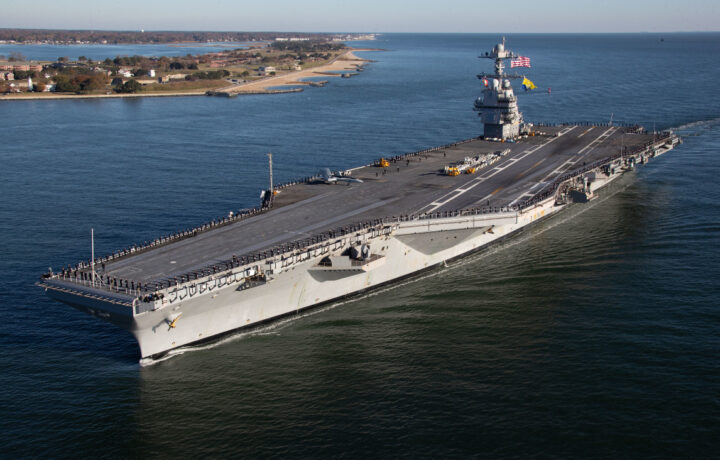The Aircraft Carrier Industrial Base Coalition (ACIBC) has warned that it could be headed for rough waters, according to a newly released survey that was conducted last November. The trade association represents about 2,000 vendors from across the country that make up the supply chain for Huntington Ingalls Industries (HII), the largest military shipbuilding company in the United States.
Those companies provide parts and services for the construction and maintenance of U.S. Navy aircraft carriers, and according to the survey it is a critical moment for the industry as 95% of the vendors have faced challenges due to rising costs from inflation, while 79% have experienced raw material cost increases of at least 7%. More than one in 10 (91%) of vendors surveyed said they faced challenges as a result of material availability or delivery, and 76% said they directly experienced an increase in the amount of time it takes to build and deliver their products.
Workforce issues also remain a serious problem, as 85% of the firms said they continue to face challenges hiring, training, and retaining their respective workforces. Moreover, 32% said that workforce-related challenges have had a detrimental impact on their ability to fulfill contracts.
Delays to Next Ford-class Supercarrier Will Supersize the Problems
The ACIBC also warned that any delay to CVN-82 – the future fifth nuclear-powered carrier of the U.S. Navy’s Gerald R. Ford-class – could further exacerbate supplier concerns. It could even cause irreversible harm to the industrial base.
The United States Navy is now planning to replace the aging Nimitz-class supercarriers on one-for-one basis with the Gerald R. Ford-class. The lead vessel, USS Gerald R. Ford (CVN-78) was years late and billions of dollars over budget. The next three vessels of the class are now under construction.
Delaying the next two-aircraft carrier buy beyond fiscal year 2028 could lead to sizeable delays, as well as growing costs, the ACIBC further warned.
“There are significant challenges that most of the companies in the supply base face,” ACIBC Chair Lisa Papini told Seapower. Those challenges include “inflation, supply chain disruption and workforce issues.”
Papini added, “Companies in the supply chain are planning work based on the stability of that schedule. When we maintain that schedule, that is when we are optimized and when we will perform at our best.”
The survey warned, “CVN 82 is forecast to be 6+ years after CVN 81 based on the President’s Budget 2024
projections (procurement in 2028); based on that timeline, nearly 50% of AP suppliers are already expected to have already stopped continuous production (i.e. “go cold”) for their respective CVN material/equipment by then.”
The ACBIC further cautioned such impact will be exacerbated if CVN 82 is delayed beyond 2028, with 40% of suppliers stating that they would need to lay off workers and/or deprioritize military shipbuilding and explore more commercial options. Moreover, if Ford-class intervals remain at six or more years beyond CVN 82, 71% of suppliers regard this as negative to their business, potentially leading to a significant cost increase in products/services, reduction in workforce, and/or exploring alternative business opportunities.
Offering the Solutions
A total of 91% of ACIBC members have called for multi-ship “block buys” as being critical to offsetting inflation, while it could contribute to the continued health and future for their respective business.
The trade association further called for earlier advanced funding, which was seen as critical by 64% of its members to address increased material lead-times and to meet required in-yard dates.
More than three quarters (76%) of those firms surveyed said that three or four-year centers are optical build intervals with 60% saying operating under four-year construction intervals would enable the hiring, retention, and training of the workforce.
The ACIBC further called for a two-ship buy, whereby the U.S. Navy would procure CVN 82 & CVN 83 under a signal contract, starting CVN 82 in FY 2028; sufficient early funding to account for longer material lead times; and consistent build intervals on 4-year centers.
Beyond Carriers
The recent survey also noted that these issues may not be exclusive to the U.S. Navy’s aircraft carriers, as more than 50% of suppliers provide parts and services for both the aircraft carrier and submarine programs.
“Of those joint CVN/submarine suppliers, at least 60% state that a stable, consistent and predictable CVN procurement strategy is critical to their overall production efforts, to include submarines,” the trade group noted.



